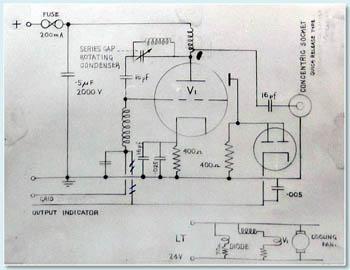
|
It is interesting also that the report says nothing of the name »Kettenhund« (this was revealed by a prisoner) and makes no mention of any manufacturer’s plate, equipment designation or serial number, information of significant intelligence value normally recorded when examining captured enemy material. These omissions again suggest that the transmitter was not a full production model. Even the recovery of the transmitter left questions unanswered: The measured frequency coverage was 162–183 Mc/s [but] when Exminster [Devon] GCI station intercepted and destroyed this Ju 188 all jamming ceased at that station which however operates on 209 Mc/s. After interrogating the pilot of U5+HH, the RAF learned that Kettenhund did not require a special aircraft and could be fitted in a bomber without reducing its normal warload, but was inaccessible in flight. It was controlled by the Bordfunker via a simple on/off switch, the frequency to be jammed being set before take-off. In its weekly report on 20 May, the Luftwaffe Signals Branch noted: Kettenhunde were used in action for the first time and seem not to have been satisfactory. Frequency drift! Mutual interference where two transmitters installed in the same aircraft. Aircraft fitted with Kettenhund remained over enemy territory [= are missing?]. Final report after Insp. Leismann’s return from IX. Fl.Kps. Unfortunately, I have not located Leismann’s report but Kettenhund trials continued over the summer with the Werneuchen test establishment reporting that on the "prototype" Do 217 equipped with eight modern Kettenhunde by BHF it was found that with antenna adjustment and normal output jamming would be perceptible on a Freya receiver up to a range of about 150 km when flying at 2000 m. A perfect jamming effect could not be established with the Kettenhund transmitters so far delivered. Target aircraft were always recognisable as dark spikes amidst the “haze” on the scope but coping with the jamming did however prove tiring for the Freya operators (who, it was thought worth saying, were female auxiliaries). The conclusion was that: “deployment of Kettenhund sets in their current form is pointless”.
A German position paper of 8 December 1944 described Kettenhund as an airborne jamming transmitter for use against British and American ground-based and aircraft radars including ASV and night fighter AI. Its frequency range was 170–220 mHz. Only provisional test results were to hand and the set had been used operationally over England but not often enough to judge its effectiveness. An improved version was however being developed. A postwar paper by Professor Leo Brandt gives the following data from jamming transmitters:
continued on next page …
|
||||||||||||||||||||||
 Experiments were also conducted at Köthen on 1 July in which a Ju 86 carrying multiple Kettenhunde tried to screen a target aircraft from a Freya. Things started to go wrong when the Ju 86’s radio failed just after take-off so no instructions could be passed to it, then frequency of the Freya set to be jammed was given incorrectly and so the wrong Kettenhunde were activated. The trial was aborted until the problems could be fixed but data collected by Technician Springbrunn of Z.V.H. Wien did establish that, “Kettenhunde of the 170–220 MHz series sometimes fall completely outside the required wavebands, wobbling between 142 and 168 MHz” and the conclusion was drawn that, “the manufacture [by Z.V.H. Wien] and installation of the Kettenhunde is not adequately supervised”.
Experiments were also conducted at Köthen on 1 July in which a Ju 86 carrying multiple Kettenhunde tried to screen a target aircraft from a Freya. Things started to go wrong when the Ju 86’s radio failed just after take-off so no instructions could be passed to it, then frequency of the Freya set to be jammed was given incorrectly and so the wrong Kettenhunde were activated. The trial was aborted until the problems could be fixed but data collected by Technician Springbrunn of Z.V.H. Wien did establish that, “Kettenhunde of the 170–220 MHz series sometimes fall completely outside the required wavebands, wobbling between 142 and 168 MHz” and the conclusion was drawn that, “the manufacture [by Z.V.H. Wien] and installation of the Kettenhunde is not adequately supervised”.